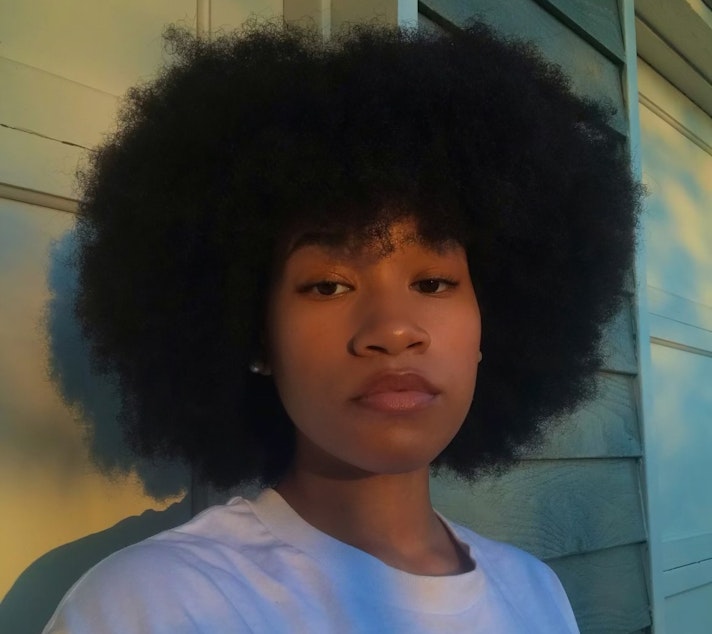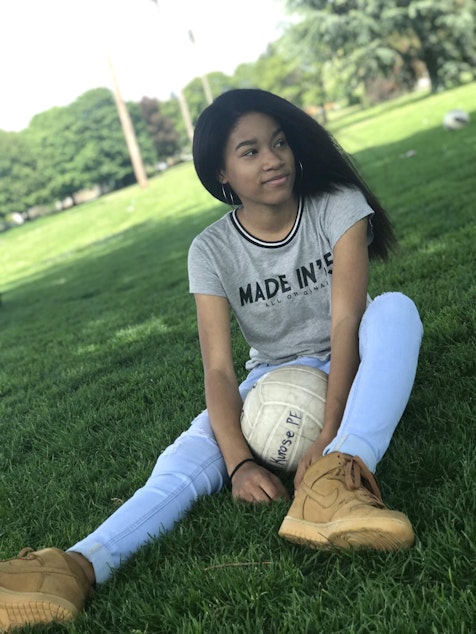Confident in herself and her curls: What my best friend's natural hair journey taught me about self-love

Nikẹ Adejumobi’s hair and self-esteem were damaged. She began the process of restoring her hair back to its natural texture. But along the way, other people's opinions left her conflicted.
RadioActive’s Alayna Ly sat down with Nikẹ to discuss the process of restoring her hair, and her journey toward self-confidence.
N
ikẹ Adejumobi's wash day routine typically takes her five to six hours. But she says its worth the time.
“Hair, to me, is definitely a form of self-expression and empowerment,” Nikẹ says. "Currently, my hair is all-natural, so there's no more damaged parts or pieces. And I’d say that it's the healthiest it's ever been since like seventh grade."
Seventh grade is when Nikẹ and I first became friends. I remember back then, her hair was always in twists. In eighth grade, inspired by other Black classmates, Nikẹ decided to try straightening her hair. And she liked it! Her hair looked very smooth and shiny. She started straightening her hair every few months.

By ninth grade, every few months had turned into every few days. The 400-degree flat iron left Nikẹ with a lot of split ends and breakage.
“If I had to put how my hair was in one word, it would just be 'lifeless,'" Nikẹ says. "It just felt pretty dead. I didn't want that anymore! I was tired of that."
Nikẹ decided to transition her hair back to its natural texture. She stopped straightening it and started using treatments to repair the damage.
These treatments were supposed to help moisturize her hair, bring out her natural curl pattern, and return elasticity to it. But after five months, they didn’t deliver the results Nikẹ was hoping for.
“My hair was all over the place in terms of how it looked," she says. "It basically had like three different patterns going on. So I was dealing with three different hair types, trying to get them all to be one."
As Nikẹ transitioned her hair, her classmates started to notice the change. Some even commented on it, saying things like, 'Oh you should straighten your hair again, it was so pretty when it was straightened!'
"I took [comments like] that as a compliment," Nikẹ says, "But also at the time I was like, ‘Oh, so you're saying that you don't like my hair right now?’”
Nikẹ didn’t know how to feel. The comments took a toll on her self-esteem. She stopped wearing her hair out and instead wore it in ponytails for the rest of ninth grade. She was afraid that if she wore it out, people would continue to judge it.
“You could say that my mind was in a similar state to my hair," Nikẹ says. "You could say that it was conflicted between going natural and wanting to be straightened again."
After some reflection, Nikẹ knew she needed to prioritize herself and her happiness. So she got a big chop. She cut off all the permanently straightened parts of her hair to make way for the natural hair growing in.
“It felt like a weight lifted off my shoulders,” she says.

Sponsored
I remember when Nikẹ sent a photo of her new hair to our group chat. She had mixed feelings about it at first. But she grew to like the haircut more and more as she experimented with different styles.
Hair was like an art form to her. It was difficult to navigate, but had fulfilling results.
“I’m in a place now where I’m a lot more confident in myself and my curls. And I can say that I’m proud of my hair, which is something that I definitely couldn't say back in freshman year,” Nikẹ says.
“I also feel a lot more proud to be a Black woman, especially to be a Black woman with big hair. It reminds me that I don't have to conform to any beauty standards to be considered beautiful or pretty."
Over these past five years of friendship, I’ve watched Nikẹ’s self confidence grow. I saw it in the subtle changes: She tried new hairstyles. Pictures of her grew more dynamic. Her smile got brighter.
Talking with her made me think about my own self-confidence.
Sometimes I get frustrated at myself for not being as confident as others. But Nikẹ’s story reminds me that self-confidence is a journey. It will be different for everyone. Take your time.
Building confidence is no easy feat. But with others around us to learn from, I think it can be a little less scary.
Sponsored
This story was created in KUOW's RadioActive Online Intro to Radio Journalism Workshop for 15- to 18-year-olds, with production support from Simone St. Pierre Nelson. Prepared for the web by Antonio Nevarez. Edited by Ann Kane. This episode was entirely youth-produced.
Find RadioActive on Facebook, Twitter, Instagram, TikTok, and on the RadioActive podcast.
Support for KUOW's RadioActive comes from the Bill & Melinda Gates Foundation Discovery Center.
If you have any feedback on this story, you can email RadioActive at radioactive@kuow.org or just fill out the box below. Reach out. We're listening.



